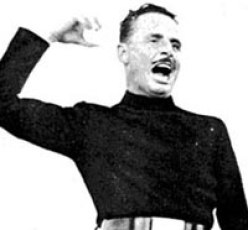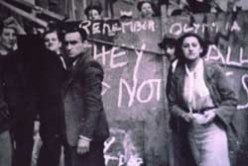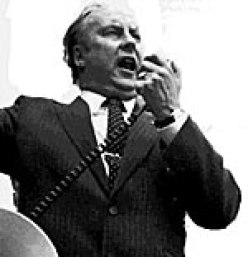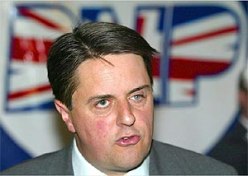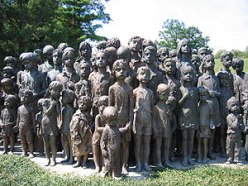British Fascism in the 1930’s
By the 1930s, British Fascism could have been a spent force. In May 1932, all that was left of the British Fascisti of Somerset fascist Linton-Orman was “three old ladies and a couple of office boys”, along with a deluge of rumours about the heavy drinking, drug-taking and wild orgies of the chief Fascisti herself. When Rotha Lintorn-Orman died, in March 1935, the organisation ceased to exist.
The great white hope for British fascism was Sir Oswald Mosley, rebellious Tory in 1918, free-wheeling independent MP in 1922, frustrated Labour shadow cabinet member in 1926, and, by 1931, a self-declared fascist.
When Labour’s response to Depression was deemed too timid by Mosley, and his own economic vision had been rejected, he resigned and formed the originally named New Party, conceived as a challenge to the discredited “old gang” of the established parties. Mosley’s New Party, however, was clearly proto-fascist. Its programme for economic recovery relied upon governance by a cabinet of ‘five dictators’, and the beginnings of Blackshirt street terror could be seen in the Mosley’s ‘biff boys’, squads of thugs who would police New Party meetings and eject undesirables.
On 1 October 1932, the New Party’s successor, the British Union of Fascists (BUF), was formed as an attempt to unify all British fascist groups. From the outset the BUF affected a paramilitary style, with ranks, Blackshirt uniforms, stiff-armed “Roman” salutes and (from 1933) a barracks-style headquarters – the Black House in Chelsea. A Women’s Section, a Fascist Union of British Workers (FUBW), a Blackshirt Automobile Club and even a fascist flying club was established.
BUF thinking was expounded by Mosley (the “Leader”) in books and party journals (in the early years Blackshirt and Fascist Week), and boiled down to variations on the theme of the Italian “Corporate State” idea. Its ideology was a typically fascist blend of nationalism, quasi-mystical romanticism and rhetoric about “modernisation”. Discreet links with businessmen and other influential high-fliers were forged through the party’s “January Club”. From early 1934, favourable publicity courtesy of Lord Rothermere, the owner of the Daily Mail (which proclaimed “Hurrah for the Blackshirts!” in January 1934), did much to swell BUF ranks. By August 1934 membership had reached 50,000.
From spring 1933, following Hitler’s rise to power, organised anti-fascism began to grow in Britain. A turning point was the BUF’s June 1934 rally at London’s Olympia, when fascist stewards brutally beat hecklers. But after opposition strength and organisation grew, anti-fascists started to get the better of the Blackshirts.
By 1934 the BUF turned to outright anti semitism. Mosley argued that “a dynamic creed such as Fascism cannot flourish unless it has a scapegoat to hit out at, such as Jewry.” But BUF membership went into free-fall, particularly after the BUF’s “Mind Britain’s Business” campaign, in support of the Italian invasion of Abyssinia.
During 1935-36, the BUF turned to Industrial recruitment drives in various regions among workers in Lancashire’s hard-hit cotton industry, and in East Anglia they campaigned with farmers resisting the payment of tithes to the church.
The BUF’s most successful localised campaign was waged in the East End of London in the midst of Britain’s biggest Jewish community, recruiting thugs and bigots such as the infamous “Mick” Clarke. By November 1936, BUF membership had grown again to 15,500.
However, anti-fascists were determined that the Blackshirts would be denied control of the East End’s streets. At the Battle of Cable Street, on 4 October 1936, a quarter of a million anti-fascists thronged the area in opposition to a planned march by 7,000 BUF supporters. The police were unable to force the march through and the BUF was obliged to call it off. Subsequently, the 1936 Public Order Act was passed, outlawing political uniforms and giving the authorities the power to ban demonstrations.
At local council elections in 1937 the BUF stood in several parts of the country but did not win a single seat. Unimpressed, Mussolini withdrew the BUF’s subsidy. Simmering antagonisms among the leadership came to a head, and Joyce and Beckett abandoned Mosley (“the Bleeder”) to form the minuscule National Socialist League.
Mosley now made several low-profile visits to Germany and in October 1936 married his second wife, Diana Guinness, in Berlin with Goebbels and Hitler in attendance. His new wife was herself an enthusiastic Germanophile whose sister, Unity Mitford, was a notorious hanger-on of Hitler.
In the late 1930s several associated pro-German and pro-appeasement groups emerged (notably the Nordic League, the Link, the Right Club and the British People’s Party); current and past members of the BUF were connected with these circles.
During 1938-39 the BUF campaigned energetically for peace with Hitler under the slogans “Britons fight for Britain only” and “Mosley and Peace”. In July 1939 Mosley addressed a “peace” rally of some 20,000 at Earl’s Court. This campaign brought new members – 22,500 in September 1939. Yet, despite this belated upturn in its fortunes, the BUF remained small and isolated.
The ’40s
By 1940 when the prospect of a Nazi invasion loomed and Britain stood alone, the state began to intern enemy aliens.
The fact that these people were refugees from Nazi terror counted for nothing and they were imprisoned alongside fascist sympathisers, British men and women who, it was believed, might become a fifth column. Mosley was detained along with his wife.
 However, some individuals who had belonged to fascist groups in Britain threw in their lot with the Nazis. William Joyce, who had been Director of Propaganda in the BUF, made radio broadcasts for the Nazis between 1939 and 1945. He was not alone. John Amery, the son of Leo Amery, also engaged in propaganda work for the Third Reich. Amery also helped raise that motley band of recruits drawn from British POWs who volunteered to fight in the Nazi cause. Some of these men had been involved earlier in fascism in Britain. Both Joyce and Amery were executed after the war for treason.
However, some individuals who had belonged to fascist groups in Britain threw in their lot with the Nazis. William Joyce, who had been Director of Propaganda in the BUF, made radio broadcasts for the Nazis between 1939 and 1945. He was not alone. John Amery, the son of Leo Amery, also engaged in propaganda work for the Third Reich. Amery also helped raise that motley band of recruits drawn from British POWs who volunteered to fight in the Nazi cause. Some of these men had been involved earlier in fascism in Britain. Both Joyce and Amery were executed after the war for treason.
The 50’s and 60’s
After the Second World War there was a revival in the fascists’ fortunes and they embarked on a new wave of terror against the Jewish community. Yet with what we know now of the war and the Holocaust, it seems extraordinary that fascism could be reborn after 1945. So what happened? How was British fascism revived?
Part of the answer is that fascism had never really gone away. Fascist groups continued to operate in many areas – the BUF was able to retain its records for safekeeping under a bridge in Hackney, and in storage, and fascists continued to meet and read and develop their politics. Members of the BUF retained a mystical belief in their leader Sir Oswald Mosley.
The fascists were also helped by a brief revival in antisemitism after 1945. Following the bomb attacks on the Kind David Hotel and the killing of the two British sergeants at Netanya during the terror campaign that launched Israel’s war of independence, there were large anti-Jewish riots in August 1947 in Liverpool, Eccles, Salford and Manchester, and smaller incidents in Plymouth, Birmingham, Bristol, Cardiff, Swansea, Devonport and Newcastle upon Tyne.
The conditions were in place for the Mosleyites to rebuild their organisation. Next, a network of Mosley book clubs was established to provide a forum to discuss the leader’s ideas and with the additional intention of recruiting a new layer of ‘respectable fascists’. Meanwhile, Mosley, Jeffrey Hamm, Alexander Raven Thomson and other well known fascists did the rounds of the small groups, encouraging even renegade anti-Mosley fascists to join the new organisation.
By the autumn of 1947, the largest fascist party, Hamm’s British League of Ex-Servicemen, was holding weekly public meetings with two to three thousand people regularly people present at the largest rallies.
It was at this stage that anti-fascist groups were set up, in the spirit of the 1930s. The Communist Party and the 43 Group both played a role in isolating Moseley’s new ‘Union Movement’ from its support.
By the summer of 1948, fascist meetings were in decline and by spring 1951, Mosley announced that he was leaving Britain for Ireland, promising never to return.
A Fascist Party would now have to be built through “permeation”, the slow takeover of sports groups, trade unions and local branches of the Tory Party, but the original movement was now in terminal decline recruiting aging Conservatives who dreamed of recreating the British Empire.
However, from these ashes arose a new breed of leader belonging to a different and more violent fascist tradition. For John Tyndall, Martin Webster, Colin Jordan and other ‘League of Empire Loyalists’ members, the League was a step on the road towards a new and purified Nazi party, the National Front, which would be formed finally in 1967.
The ’70s and the NF
During the 1950s, it was becoming clear that Britain’s newly emerging black population was not universally welcomed. Race riots erupted, followed by widespread discrimination in housing, the labour market and public facilities, with increasing racial violence (including notorious incidents in Notting Hill and elsewhere in 1958), and with growing pressure from the political mainstream to restrict immigration from the Commonwealth.
By the ‘swinging’ 1960s, the country witnessed clearly racist campaigns by elements of the Conservative Party (as in Smethwick and Slough), most notably demonstrated by the disturbing levels of support given to Enoch Powell after his April 1968 “rivers of blood” speech.
By the 1970s, the National Front (NF) had been formed from the amalgamation of several earlier racist or extreme-right groupings, including the League of Empire Loyalists, and the Racial Preservation Society, to be joined by John Tyndall, Martin Webster and others from the Greater Britain Movement, a tiny group of overt Nazi sympathisers. The NF had made a modest impact in local and parliamentary by-elections in the late 1960s but by the elections of the 1970s the NF was one of the first extreme-right parties in Europe to use crude expulsionist anti-black and anti-Asian racism as the prime basis of its electoral appeal.
During the early 1970s, the NF became well implanted in a number of provincial cities and in some western boroughs of London. In a notorious 1972 Uxbridge parliamentary by-election, when public reaction to the arrival of expelled Asians from Uganda was still at its most intolerant, the NF candidate was openly assisted by members of the Conservative fringe organisation, the Monday Club, and won more than 8 per cent of votes cast.
At a by-election in West Bromwich in May 1973 Martin Webster, the party’s National Activities Organiser, won more than 16 per cent of votes cast in a low-turnout contest. The two general elections of 1974, particularly that in October, were remarkable for showing new centres of NF support based on London’s inner and extended East End, which became the NF’s most consistent location of strength, having for more than a century been intermittently drawn to political movements against one-time immigrant groups, whether Jewish or Bangladeshi.
In 1975 the NF was threatened by a split, around the former Conservative John Kingsley Read, who founded a breakaway party called the National Party of the United Kingdom (NP) in an attempt electorally to marginalise the NF.
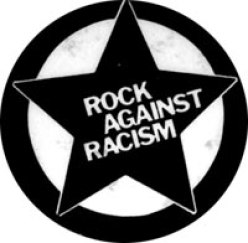 However, the far-right grew and the NF’s performances in the Greater London Council elections of early May 1977 provided considerable publicity for the party and evoking much concern, especially on the left, about the danger it posed. These results were one factor leading to the formal foundation of the Anti-Nazi League (ANL) in late 1977.
However, the far-right grew and the NF’s performances in the Greater London Council elections of early May 1977 provided considerable publicity for the party and evoking much concern, especially on the left, about the danger it posed. These results were one factor leading to the formal foundation of the Anti-Nazi League (ANL) in late 1977.
In May 1978, associated with a lot of anti-NF publicity material from the ANL, it became very apparent that the NF was not holding all its support, so when In the 1979 general election the party put all its resources into an electoral effort including a boast by Tyndall in the party’s one radio election broadcast that “in some places we shall beat the Liberals”, nowhere did this happen and the NF’s total of 303 candidates averaged a humiliating 1.3 per cent of votes cast in their contests.
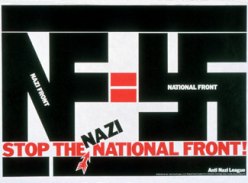 The party then imploded, disintegrating into several different groups and factions in 1979 and 1980. Its earlier leaders lost control as a disgruntled younger generation manoeuvered for power. Webster was suspended from membership amid insinuations about his sexual orientation that had previously been muted. In January 1980 Tyndall was obliged to resign his chairmanship, to be replaced by Andrew Brons.
The party then imploded, disintegrating into several different groups and factions in 1979 and 1980. Its earlier leaders lost control as a disgruntled younger generation manoeuvered for power. Webster was suspended from membership amid insinuations about his sexual orientation that had previously been muted. In January 1980 Tyndall was obliged to resign his chairmanship, to be replaced by Andrew Brons.
In June Tyndall left the party, first to found a so-called New National Front and then in 1982 the British National Party (BNP).
Revival in the 80s
When major civil disorder broke out in the early 1980s, first in Bristol, then in Brixton, Toxteth and elsewhere, the fascists found it difficult to capitalise on it.
Membership of the National Front (NF) was down to under 4,000 and of John Tyndall’s New National Front to around 2,000. British Movement (BM) supporters were mainly involved in football violence.
It was, instead, Margaret Thatcher’s Conservative government that was able to present itself as the party of “law and order” in the face of “mob” violence. Throughout the 1980s the largely Tory-run press carried stories about race and “loony” left-wing councils that would not have been out of place in fascist publications. The fascists’ clothes had well and truly been stolen by the Conservative Party, and former Tories who joined the NF in the 1970s largely returned to their old political home.
The Conservative government waged a war on Britain’s left, striking at its very heart, the trade union movement and the National Union of Mineworkers. The defeat of the miners in 1985, after one of the country’s most bitter strikes, was to be a watershed for Britain’s Labour Movement and a severe blow for the left.
The radical right-wing agenda pursued by the Thatcher government, breaking the postwar political consensus, was the product of what became known as the New Right. A series of pressure groups and think-tanks around the Conservative Party, such as the Monday Club, Tory Action and the Salisbury Group, pushed an agenda that called for tough immigration controls (even repatriation) and widescale privatisation of industry. The Federation of Conservative Students, the party’s official campus wing, became so extreme that it was closed down.
The “Third Position”
John Tyndall formed the British National Party in 1982 and continued publishing his monthly magazine Spearhead. The most significant developments took place in the NF, with activists looking to pre-Hitlerite national revolutionary and Strasserite ideas as a way of taking the movement forward. Michael Walker’s magazine, Scorpion, provided a forum for these discussions.
During the early 1980’s In Germany, France and Italy a wave of extreme-right bombings took place. In Italy, the bombings, which took over 100 lives, were carried out by the Armed Revolutionary Nuclei (NAR), a cell-structured organisation that advocated a style of fascist politics known as the third position. It transpired that the NAR was linked to the security services. These terrorist activities proved inspirational to the NF Italian fascists wanted for a series of killings and bank robberies and in connection with the bombing of Bologna railway station, were provided with safe housing in Britain.
This was facilitated by the League of St George, a small fascist umbrella organisation. Led by Roberto Fiore, the Italians made contact with the NF’s young guard – most notably Nick Griffin, Derek Holland and Joe Pearce. Fiore, Holland and others worked jointly on a magazine called Rising, which put across the new thinking of the younger faction. Holland went on to produce a booklet, The Political Soldier, which became their guiding publication. It was paid for by Fiore and his friends. This new regime ran down the party’s membership as it sought to retain only those who were committed to the ideological shift and would become “political soldiers”. The idea was to carry forward a leaner but fitter NF armed with both anti-communist and anti-capitalist rhetoric.
By the late 1980s, the political soldier wing of the NF had made drastic changes to its policies, dropping public racism and replacing it with support for black nationalists such as Louis Farrakhan, travelling to Libya and coming out in support of Colonel Gaddafi’s regime. The leaders of this group were Griffin, Holland and Patrick Harrington.
Blood and Honour
Although the NF was declining, there was one area that was a success, namely the organisation’s music wing, Rock Against Communism. Nazi skinheads remained an integral part of the British fascist scene in the early 1980s, led by Nicky Crane of BM and Ian Stuart Donaldson, lead singer of the band Skrewdriver. Another key figure in organising young people through the NF magazine Bulldog was Pearce. During the 1980s all three of them were sent to prison for various offences.
Skrewdriver and other racist bands played concerts across Britain, building their following and gaining a legendary status abroad. A major venue for these music events was Griffin’s father’s farm in Suffolk.
In June 1989 the BNP held a ‘Rights for Whites’ rally in Dewsbury, Yorkshire. Mainly Asian youth came out to confront them and 82 anti-fascists were arrested. By the end of the 1980s the BNP had begun to emerge as the main fascist street force. The NF Flag group, now led by Ian Anderson, was still street active, though on the decline. By January 1990 the Flag group was able to claim the NF mantle as the political soldiers officially closed down the NF. Before long the political soldiers split into two: the International Third Position led by Griffin and Holland and the Third Way, led by Harrington and Grahame Williamson.
The decade closed with the cataclysmic collapse of Communism in East Europe – for which Reagan and Thatcher were seen as responsible with pro-western democrats as the benefactors – yet in the ensuing vacuum, fascist movements were reborn once again.
Blood and Honour capitalised on this in the climate of a new-found fascist internationalism. Within a short time, in Germany, Eastern Europe and the United States fascist youth were sporting the dress style of Britain’s skinheads and listening to the music of the Blood and Honour bands. Britain’s fascists entered the 1990s with brighter prospects than when the decade began.
The 1990s
The 1990s was a bridging period for fascism in Britain with street fighting amongst violent Neo-Nazi groups like Combat 18 attempting to sit alongside respectable electoral success like the first BNP council victory in Tower Hamlets in 1992. Yet at the same time a bloody internal battling for position in their dark little world bucked the trend of mainstream politics where the centre and ‘relative’ left were uniting behind first Major to get Thatcher out then Blair to get the Tories out.
A main cause of division for the Conservative Party – seemingly in freefall by now – was Europe and although the BNP mopped up some of the far right vote at the 1997 Election most of the Tory Far Right anti-Europe vote went to the newly formed UK Independence Party.
By the late ’90s, Tyndall was history and Nick Griffin seized his moment by trying to position the BNP as a ‘respectable’ party which could appeal to Middle England (as everyone else seemed to be trying to!)
All Tomorrows Fuhrers
Nick Griffin
Born in Barnet in 1959, Griffin was introduced to the NF as a teenager by his Conservative father, Edwin. Griffin’s grandfather also showed him some of the more antisemitic literature of Oswald Mosley’s British Union of Fascists.
After attending St. Felix public school near Southwold, Griffin studied at Cambridge University, where he rose through the ranks of the Young NF before being appointed to the main party’s National Directorate in 1980 where he helped found & edit Nationalism Today.
In 1986 the NF’s bitter feud saw “radicals” grouped around Griffin and Derek Holland proclaiming themselves the “official” NF while “reactionaries” coalesced around Martin Wingfield and Ian Anderson, who established the NF “Support Group”.
Griffin wrote a particularly vituperative pamphlet entitled Attempted Murder: The State/Reactionary Plot Against the National Front, in which he railed against his opponents accusing them of doing the state’s dirty work.
His far right pedigree is evidence by such testimony as the Scottish Blood and Honour boss Steve Cartwright who went on record with his memories of Griffin in Wales in the mid-1990s. “Our meeting with Griffin went well,” recalled Cartwright, “he pushed all the right buttons, emphasising militancy as well as paying due respect to the Nationalists and National Socialists of the past. He also spoke of the need to re-package and modernise our beliefs in the hope of reaching the British public.”
He went away satisfied that this was the man to succeed the veteran BNP leader, John Tyndall.
Race Hate
Griffin’s trial in 1998 on race hate charges arising from statements denying the Holocaust in The Rune, a magazine that he edited, and his Holocaust denying performance on The Cook Report further impressed the hardline Nazi faction within the BNP that “our man had balls”. During the leadership election campaign Griffin used Tony Lecomber, who had served two three-year prison sentences on explosives charges and for assaulting a Jewish teacher, as his hatchet man to circulate the most defamatory personal smears against Tyndall. In September 1999 Griffin was elected chairman.
 Electoral breakthrough
Electoral breakthrough
Under Griffin’s leadership the BNP made an electoral breakthrough to get three members elected to Burnley council in 2002, and went on to win further local elections in the following years in Barking and Stoke.
Holocaust denial
Griffin finally joined the BNP in 1995 and soon gravitated towards the hardline Croydon branch, which included a number of the party’s most ardent antisemites. Soon afterwards Griffin began to contribute to The Rune, an antisemitic magazine published by Paul Ballard and his comrades. Ballard was a veteran BNP member and sympathiser of the Nazi terror group Combat 18.
Griffin became editor of The Rune in 1995. Tyndall had no problem with this and the following year appointed him editor of his own magazine, Spearhead.
The Rune showed Griffin to be a hardliner par excellence. He used the publication to argue forcefully against modernising the BNP, stating that “the electors of Millwall [who voted in the BNP’s first local councillor in 1993] did not back a post modernist rightist party but what they perceived to be a strong, disciplined organisation with the ability to back up its slogan ‘Defend Rights for Whites’ with well-directed boots and fists. When the crunch comes power is the product of force and will, not of rational debate.”
As editor of The Rune Griffin plumbed new depths in antisemitic invective. It became a platform for glorifying the British Union of Fascists and Hitler’s SS, and for describing the Holocaust as the “holohoax”.
Comments such as these led to his house being raided by the police in 1997 and he and Ballard being hauled before the courts for inciting racial hatred. Ballard pleaded guilty but Griffin chose to contest the charges, inviting a number of “expert” witnesses to testify for him at his trial in 1998 including the noted French Holocaust denier Robert Faurisson. The effort was in vain. Griffin was found guilty and handed a nine-month prison sentence suspended for two years.
It was during his defence that Griffin made his notorious statement: “I am well aware that the orthodox opinion is that 6 million Jews were gassed and cremated and turned into lampshades. Orthodox opinion also once held that the Earth was flat … I have reached the conclusion that the ‘extermination’ tale is a mixture of Allied wartime propaganda, extremely profitable lie, and latter witch-hysteria.”
Griffin has also attacked the “revisionist” writer David Irving for admitting that some Jews may have been killed during the “holohoax”, accusing him of “back tracking on the old gas chamber lie”.
In 1997 Griffin wrote the pamphlet, Who Are the Mindbenders? an antisemitic tirade against what he saw as Jewish control of the British media, the means by which, Griffin alleged, Jews were trying to brainwash white people into accepting multiculturalism.
The BNP always rejects accusations that Griffin is antisemitic, claiming it was all in the distant past. This is far from the truth. As recently as April 2007 Griffin told a reporter that he did believe in the Holocaust but only because “European law” required him to do so.
Political soldiers
As leader of the BNP Nick Griffin has put in place a system of voting members who are required to undergo ideological training and has been unconcerned at the departure of officers and members unwilling to follow his every command.
Griffin’s desire to build a political elite along the lines of the political soldiers combined with his obsession with a coming civil war or race war also shows how little his politics have changed in over 20 years.
Griffin is still prepared to work with whomever he thinks can help him get what he wants, the more shadowy they are the better- Lance Stewart, the South African former police officer who heads the BNP’s “intelligence department”, Arthur Kemp, the former South African spook who runs ideological training, and Lambertus “Bep” Nieuwhof, a convicted pro-apartheid terrorist who provides internet services.
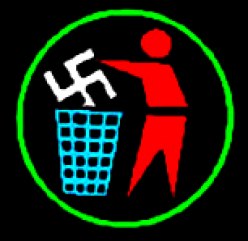 In 2009 the BNP policy of ‘respectability’ saw them making major gains in Council and London assembly elections with more seats than they ever dreamed possible.That same year Griffin and Brons were elected as Members of the European Parliament. While some defend their right to exist and spread their propaganda as if the very democracy itself depended on it, others realise where freedom to be Fascist will lead and adopt the simple principle
In 2009 the BNP policy of ‘respectability’ saw them making major gains in Council and London assembly elections with more seats than they ever dreamed possible.That same year Griffin and Brons were elected as Members of the European Parliament. While some defend their right to exist and spread their propaganda as if the very democracy itself depended on it, others realise where freedom to be Fascist will lead and adopt the simple principle
During the years 2010 -2020 the British Fascists were marginalised and far right politics focused on groups such as the EDL (English Defence League) and Britain First, however with the rise of UKIP on the right of the Conservative Party and promoting anti immigration and anti European Union politics these views became subsumed in a more ‘populist’ ‘Brexit’ view of a significant number of the British electorate and were eventually taken on board by the Conservative Party. By 2020 UKIP and it’s heir the Brexit Party had become irrelevant as the British Tories now adopted many of their policies and positions.
NO PLATFORM FOR FASCISTS.
Fight Fascism
This page shows the history of the British Far Right, British Fascism, its offshoots, its legacy, its heirs and pretenders and the fact that IT’S NEVER GONE AWAY.
The text reproduced is from the organisation SEARCHLIGHT – a campaign group that have monitored the activities of Nazis, Neo Nazis and Would-Be Nazis every step of the way.
To keep up to date with the latest news from the Anti-Fascist struggle click on the Searchlight website.
